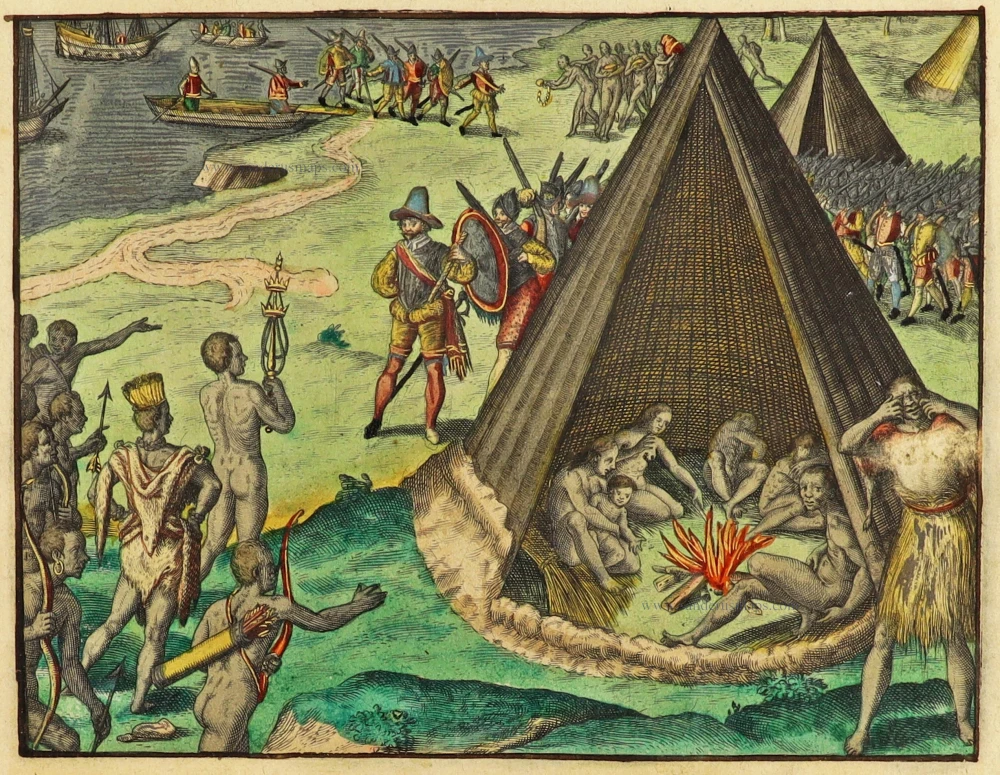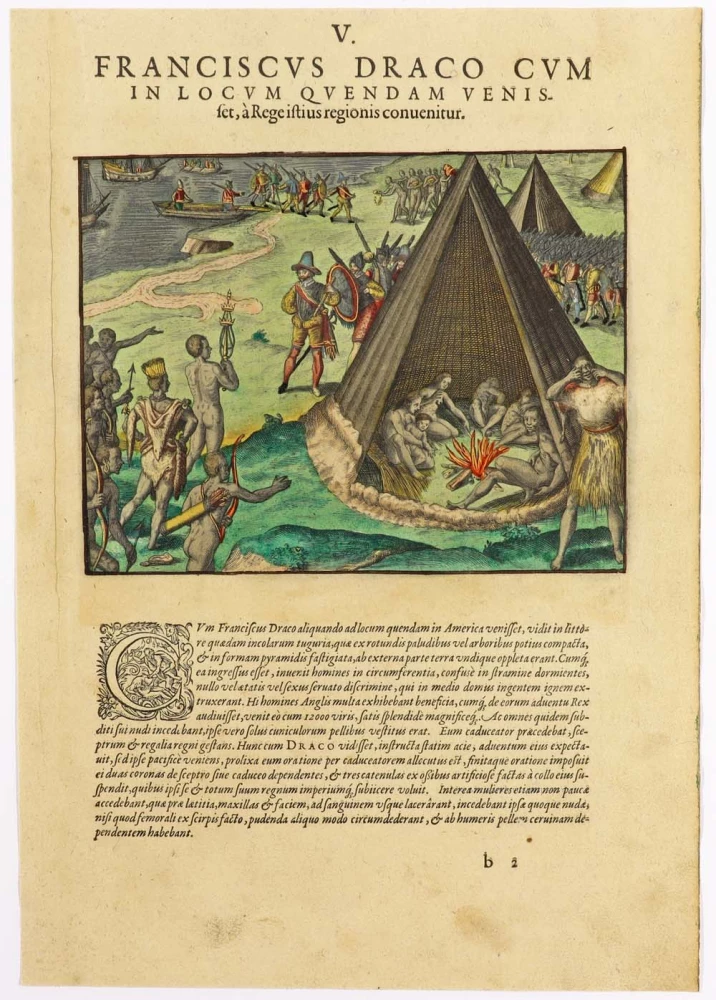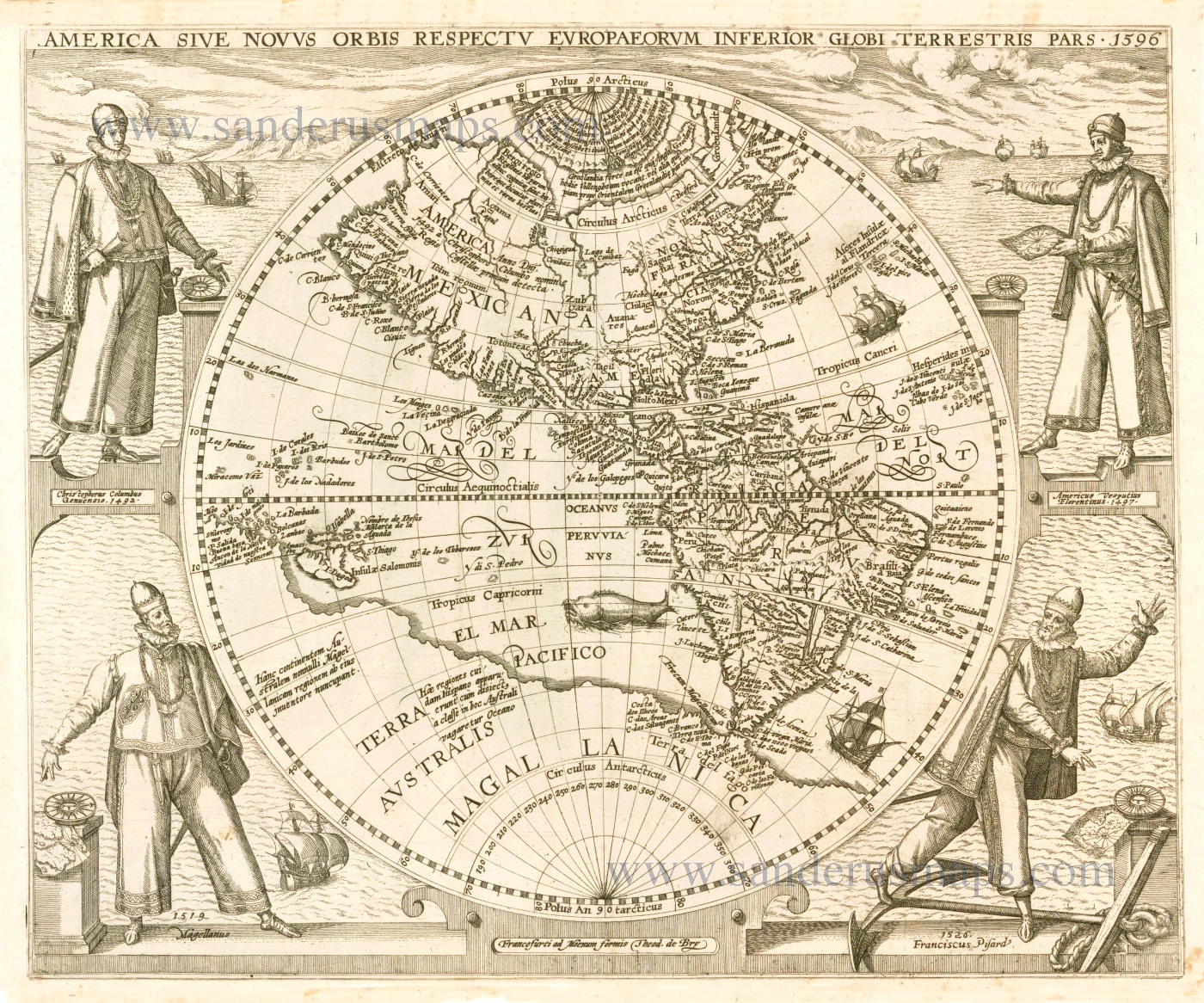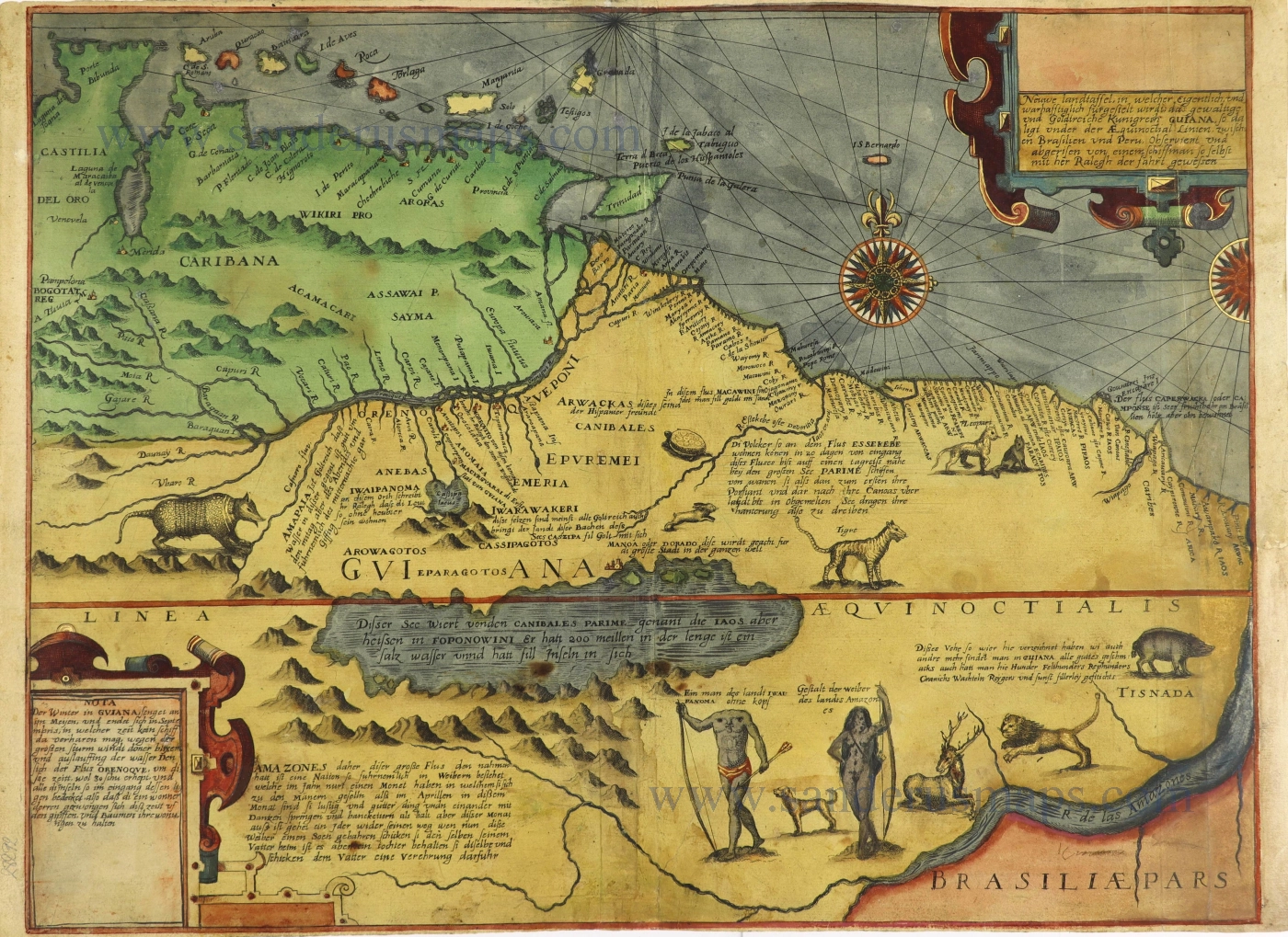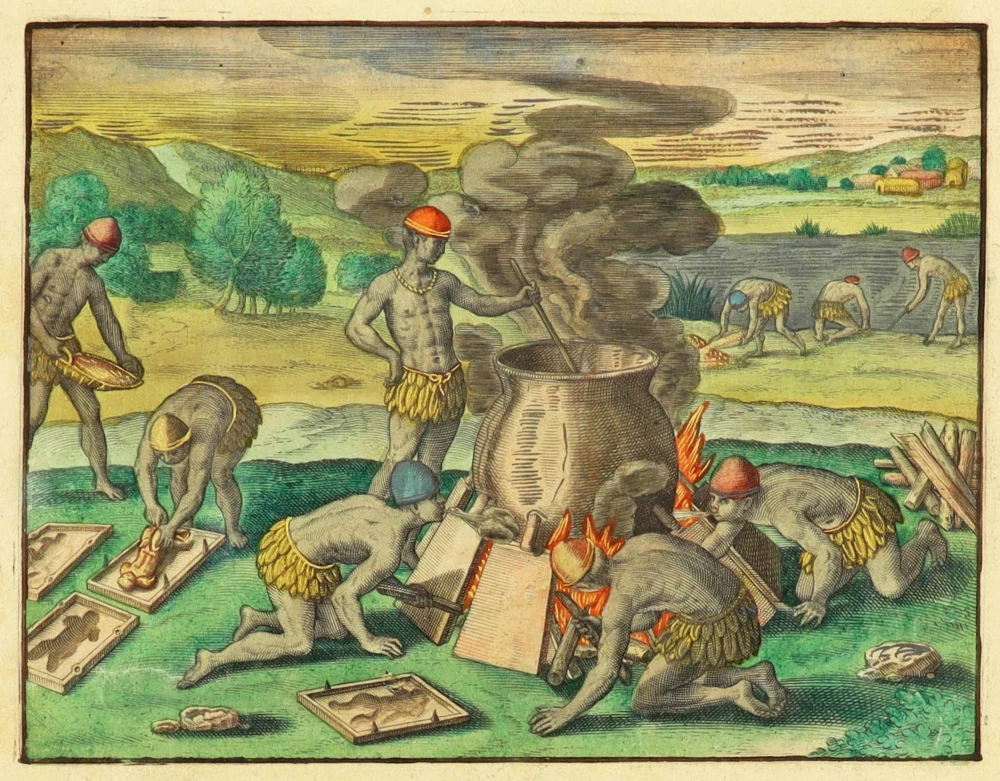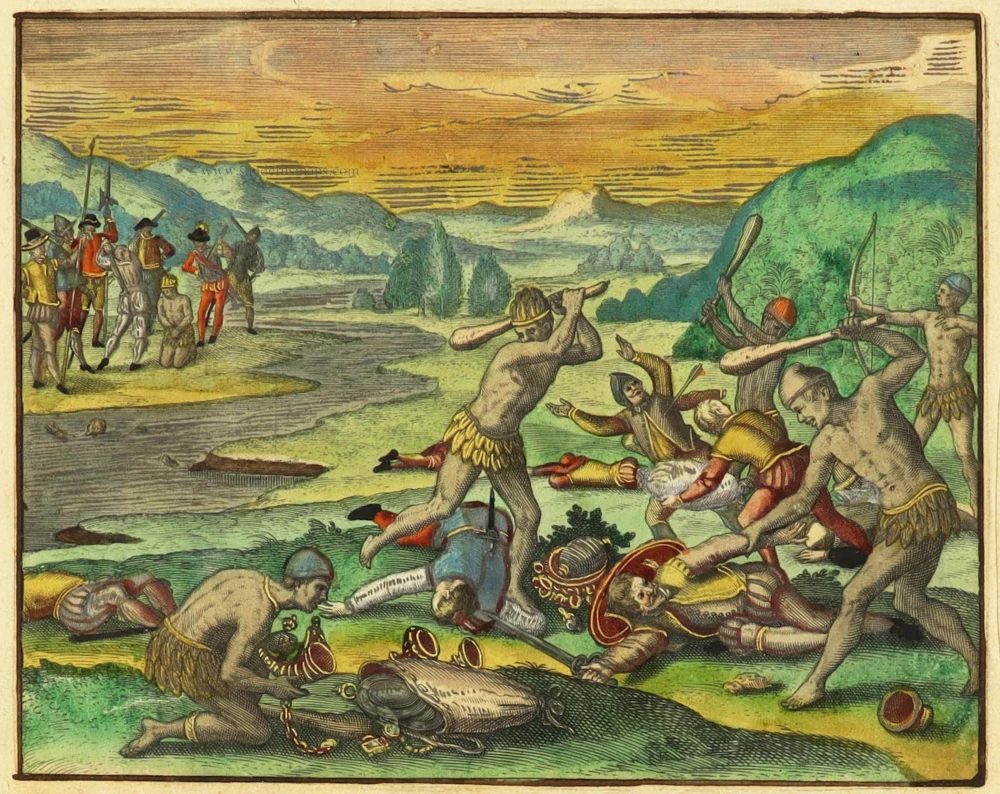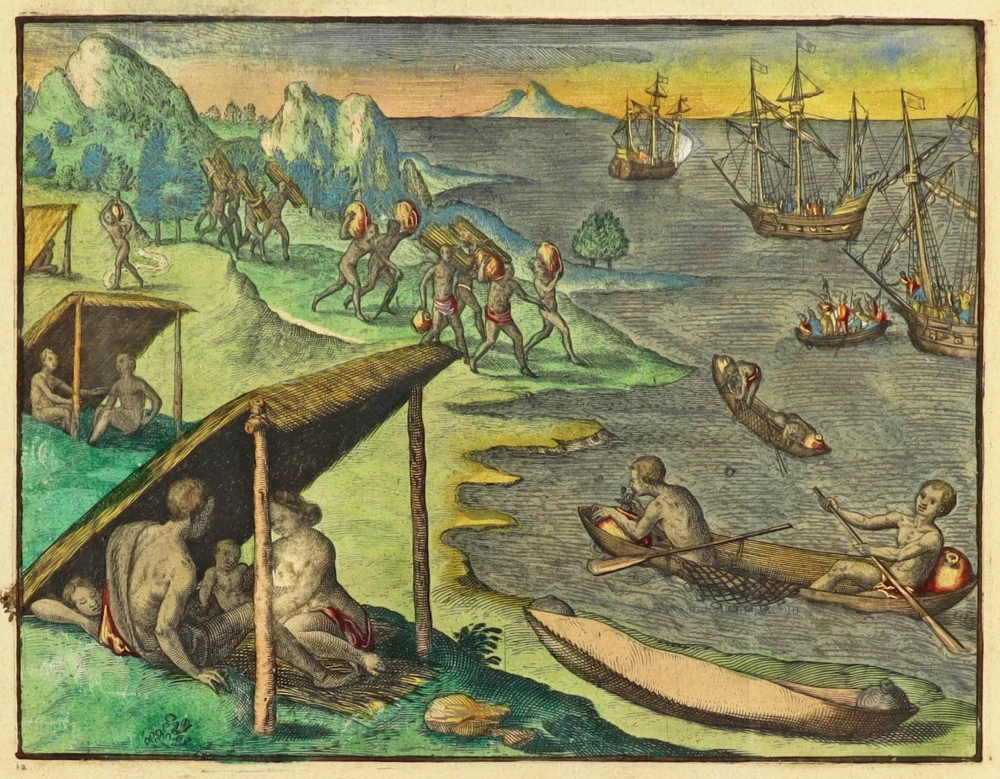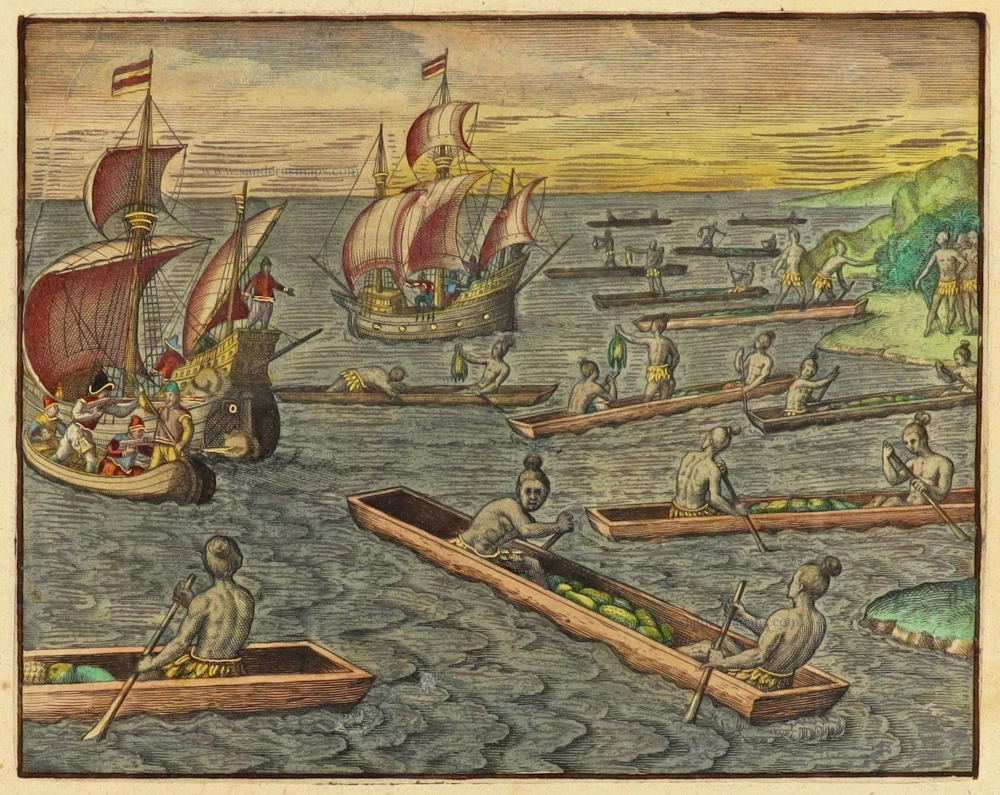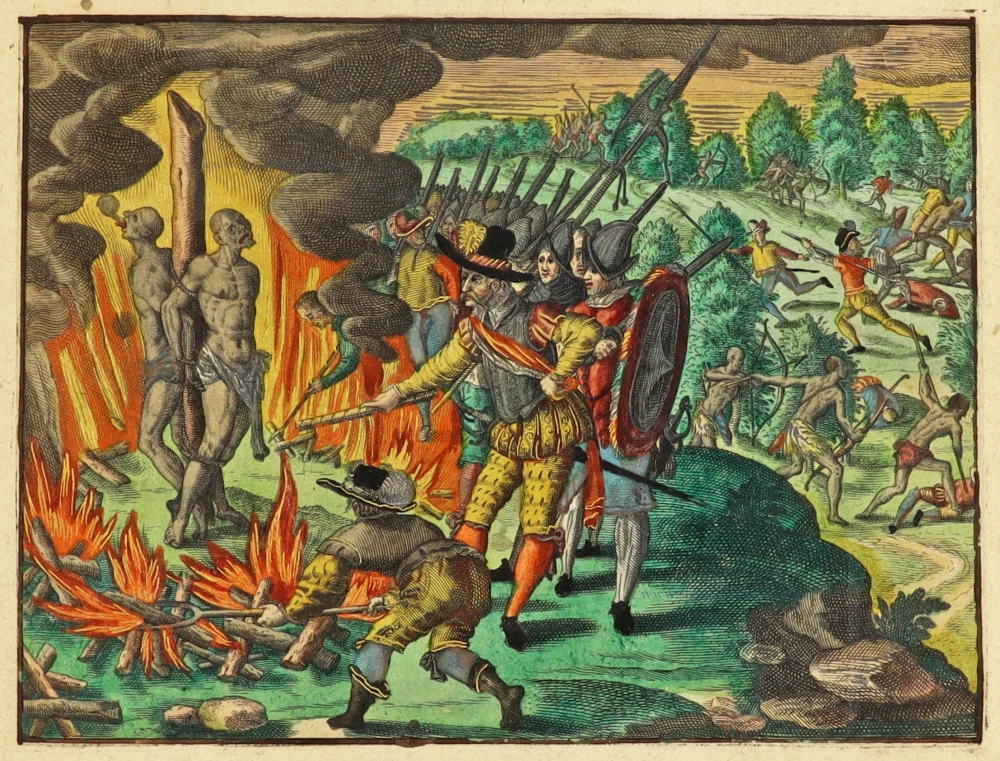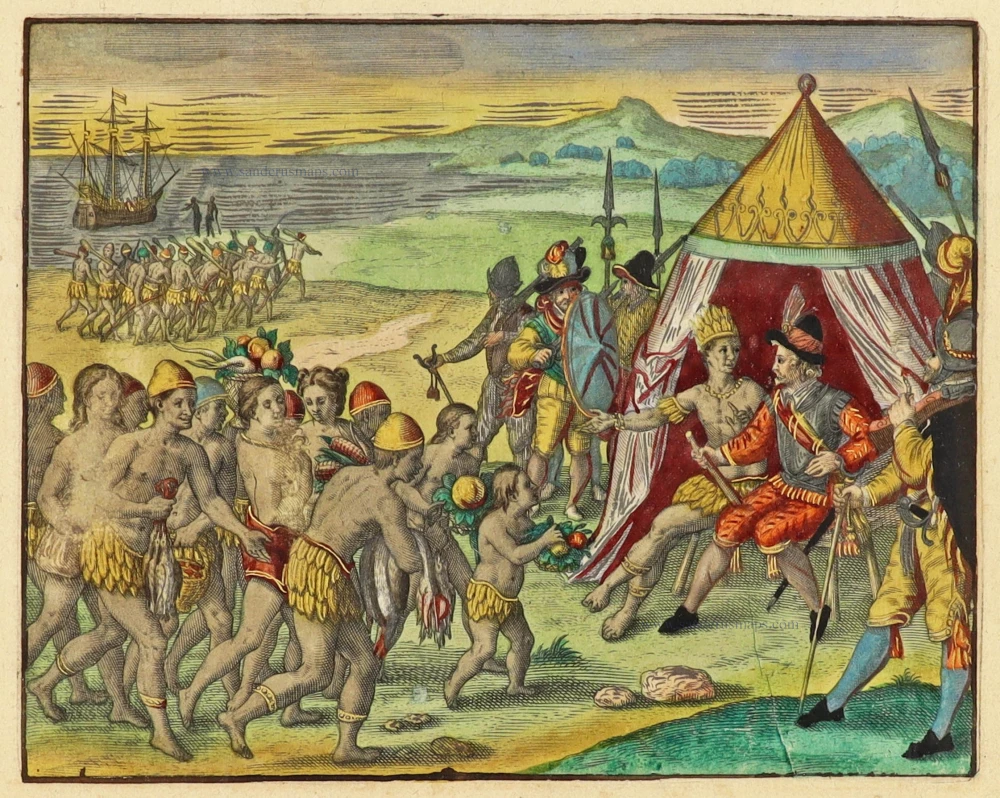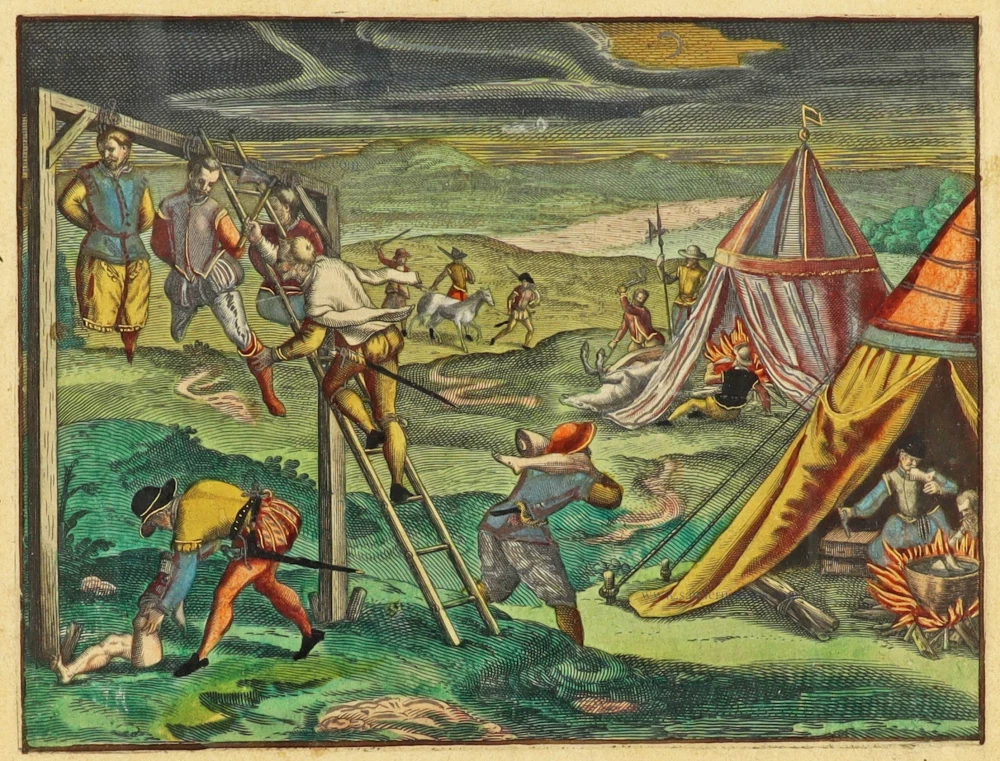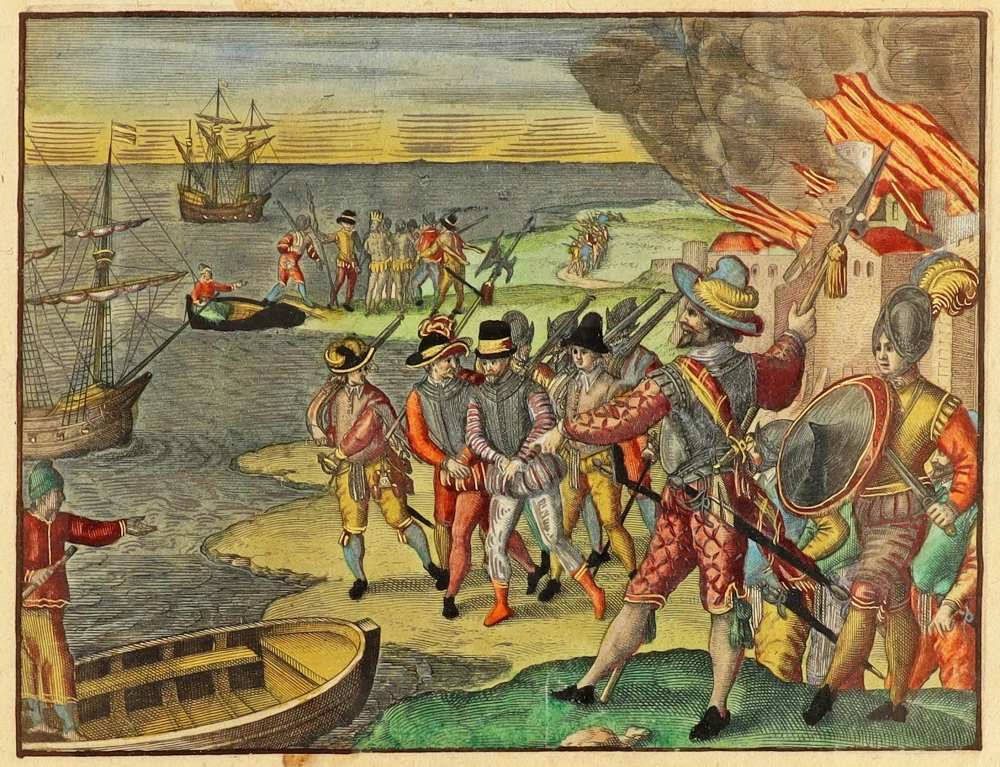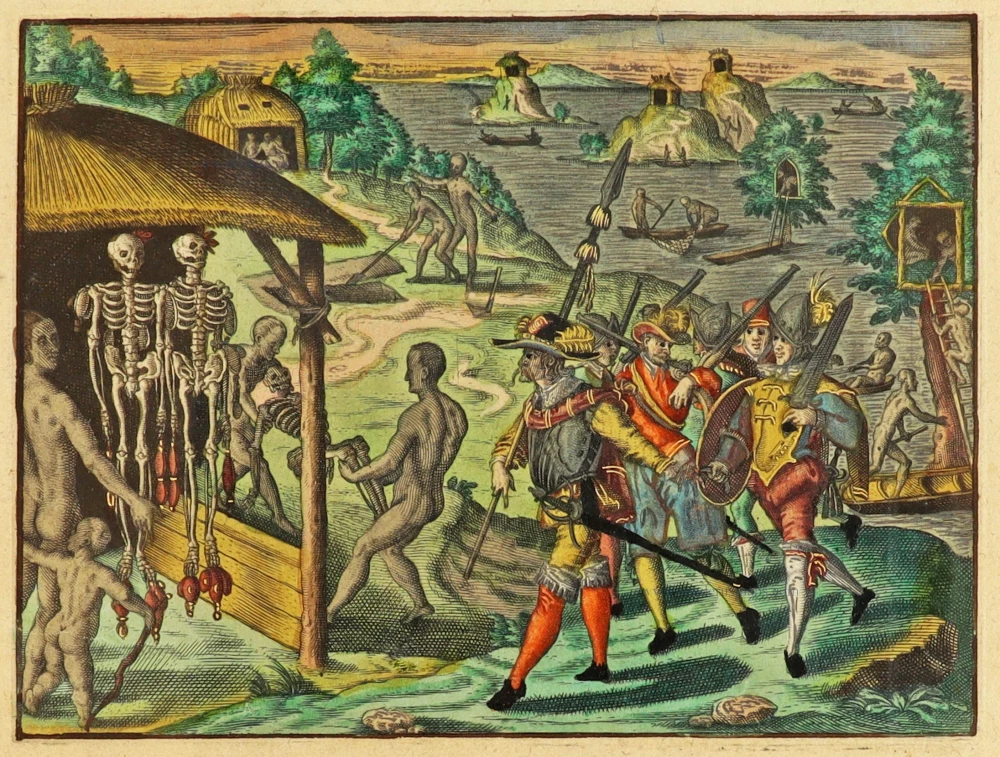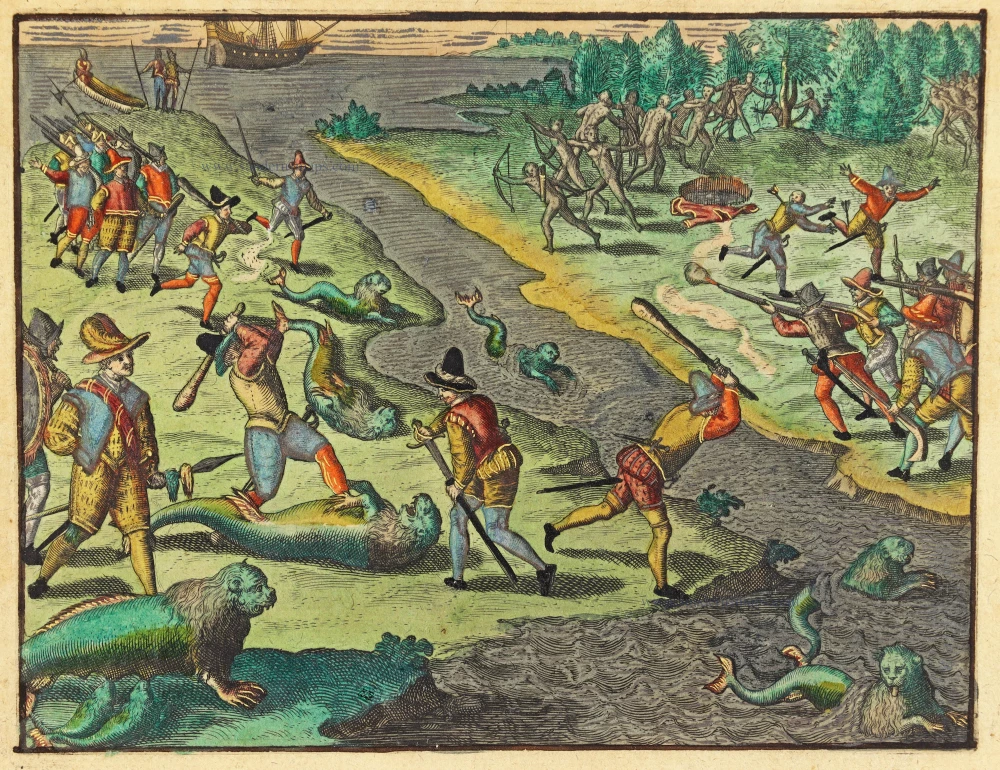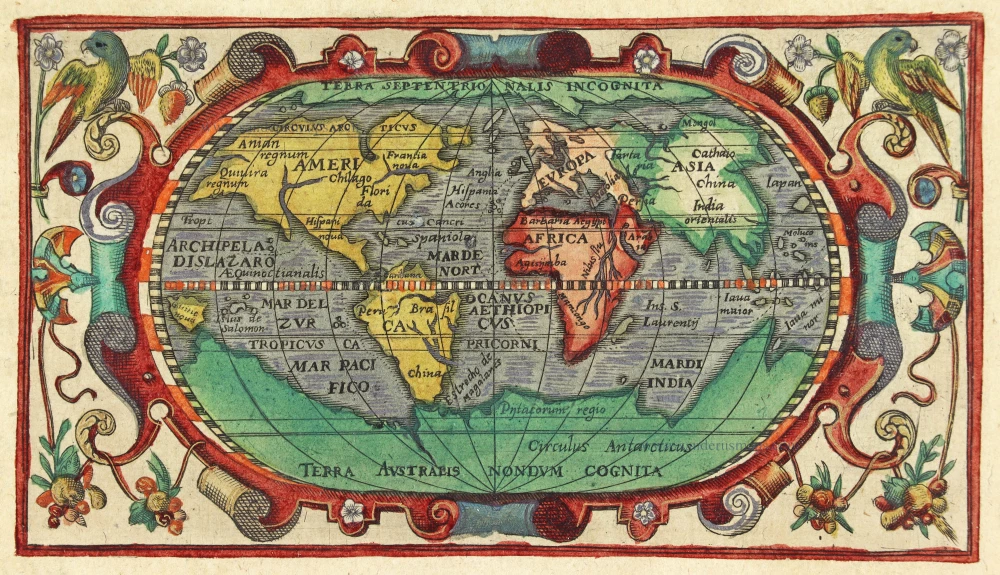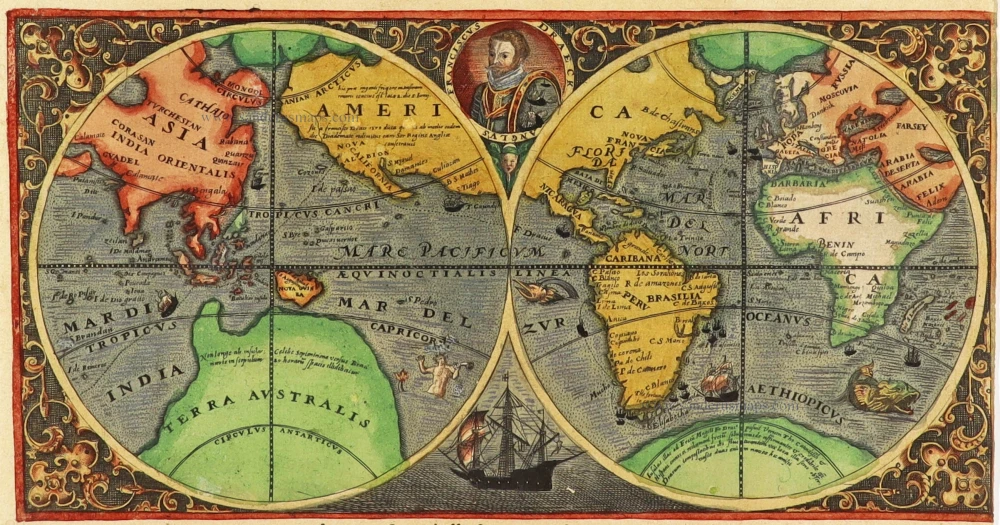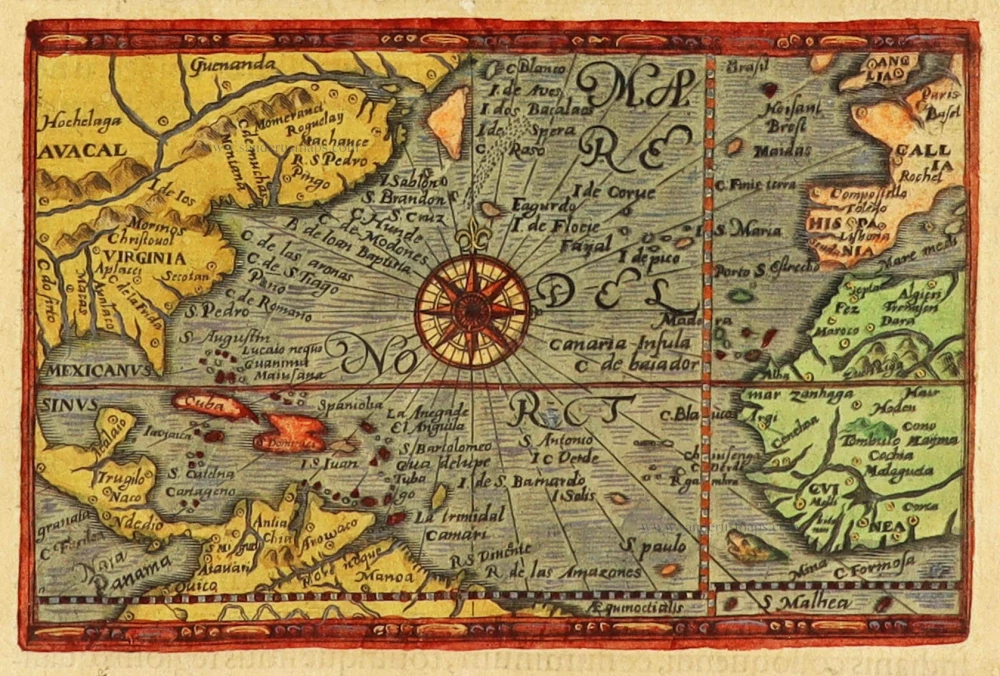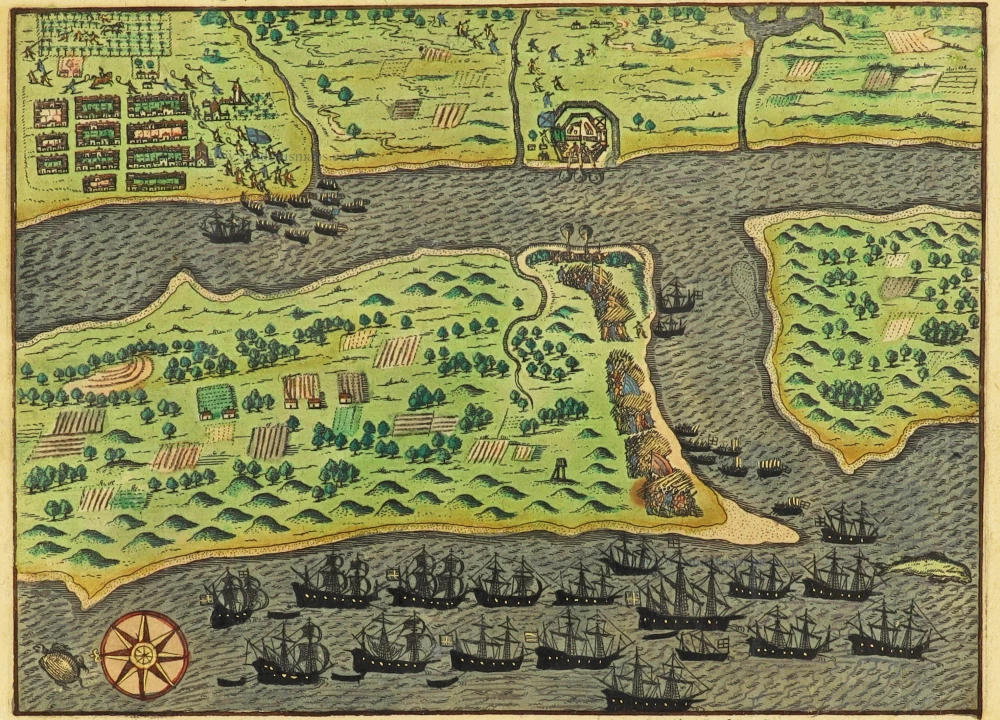Heightened in gold and silver
How Francis Drake arrives at a place where the king meets him, Great Voyages, De Bry, 1599
TRANSLATION: "When Francis Drake journeyed on, he eventually came to a place where he saw some huts built on the shore made of poles and masts, pointed on top and rounder at the bottom. Outwardly, they were pretty high and secured in the ground, but inside, the poor people - mother, father and child - sat in a circle on straw, for they had no other bed—a fire burned in the centre of the house. As told in the account, these people honoured the visiting Englishmen with gifts. The king also appeared, which was uncommon. He heard that the Christians had arrived, and he called together 12,000 men to accompany him in great magnificence. Although his subjects were all naked, the king wore robes of rabbit fur and other animals. A herald preceded him, carrying his sceptre. When Francis Drake saw these people approaching, he ordered his men into a battle formation. The king, however, gave him signs of peace and held a long speech via his herald. When the speech was over, he had two crowns placed on Francis Drake's head, and three wonderfully crafted ivory necklaces hung around him. Through this ceremony, the king intended to make his entire kingdom subject to Francis Drake and his regiment. Furthermore, some women scratched their faces for joy until they were bloody. They also went naked, but they had aprons made of rushes and other such things that they hung on their bodies, as well as deerskin over their shoulders. " (Van Groesen - Tise)
Theodore de Bry (1528 – 1598) and his family.
Theodore de Bry was born in 1528 in the Prince-Bishopric of Liège in the southern Netherlands (today Belgium). Trained as a goldsmith in his father's workshop, he left his home town around 1558 and moved to Strasbourg. Religious motives partly inspired his emigration, but commercial incentives were probably more critical for de Bry since Strasbourg was more attractive. Here, he gradually began to shift his focus to copper engraving. In the early 1560s, Theodore married Strasbourg-born Katharina Esslinger, and the couple went on to have four children together before Katharina died c. 1569. Johan Theodore (b. 1563) and Johan Israel (b. 1565) followed in their father's footsteps and took up his trade. He remarried in 1570 to Katharina Rölinger.
In 1577, after the Pacification of Gent had quietened religious tensions in the Netherlands, Theodore and his family moved to Antwerp. There, they lived close to the printing house of Christopher Plantin, and it was there that Theodore began making copper engravings. Copper engraving was a well-developed art in the Low Countries, and Antwerp artists were in great demand. In 1584, when Catholic troops besieged Antwerp, Theodore and his family moved to London, where he made copper engravings for an essential English navigation manual, The Mariners Mirrour. He also found the inspiration to produce the collection to which his name would forever be attached.
He met the artist Jacques Le Moyne de Morgues, a draughtsman who had been to Florida in the 1560s as part of a French expedition. He returned to Europe with watercolours of the natural world he had seen and the indigenous peoples. After Le Moyne's death, thanks to the mediation of Richard Hakluyt, Theodore acquired these drawings.
Hakluyt and de Bry began collaborating on a series of books about America. In 1588, the de Bry family moved to Frankfurt, where Theodore published the first volume of the America series. This first volume was the only one in the collection that appeared in four different languages: German, Latin, French and English. The following volumes appeared only in German and Latin. As a result, the relationship between de Bry and his English partners quickly soured.
Theodore continued publishing and produced a blend of richly illustrated prestigious volumes of the Voyages collection, the family firm's flagship publication.
Theodore de Bry died on March 27th, 1598. At this time, the highly successful and lucrative America series had already extended to seven volumes, and there would be fourteen. To these must be added the 'Elenchus', published in 1634 by Merian, which was a collective title and table of contents of these same volumes.
In 1597, the de Bry brothers published the first volume of the East India series. These were also published in folio but with slightly smaller page sizes than the America volumes. To distinguish the East India series from his America series, the two parallel sets subsequently became known among bibliophiles as de Bry’s Petits Voyages and his Grands Voyages, respectively.
The Petits Voyages consist of thirteen volumes, published between 1597 and 1633.
After Theodore de Bry's death, the business was run by his son, Johann Theodore and then by his grandson, Matthäus Merian and grandson-in-law, William Fitzer. Precisely what part de Bry's widow and his other son played in the business is unclear, but they certainly seemed to have retained some interest. After all, it must have become a very profitable venture for the whole family. Together, they continued to publish volumes of the Grands and Petits Voyages for another 46 years. The last volume, a third edition of Part IV of the America series, finally appeared in 1644.
Franciscus Draco cum in locum Quendam venis fet, a Rege istius regionis conuenitur.
Item Number: 30738 Authenticity Guarantee
Category: Antique maps > America > South America
How Francis Drake arrives at a place where the king meets him, Great Voyages, De Bry, 1599.
Title: Franciscus Draco cum in locum Quendam venis fet, a Rege istius regionis conuenitur.
Date of the first edition: 1599.
Date of this map: 1599.
Copper engraving, printed on paper.
Image size: 135 x 175mm (5.31 x 6.89 inches).
Sheet size: 315 x 220mm (12.4 x 8.66 inches).
Verso: Blank.
Condition: Beautiful original coloured and heightened in gold and silver, some small wormholes restored.
Condition Rating: A.
From: de Bry Theodore, Grand Voyages. - [Voyages of Sir Francis Drake, Thomas Candish and Sir Walter Raleigh.] Americae pars VIII. Continens primo, descriptionem trium itinerum nobilissimi et fortissimi equitis Francisci Draken, qui peragrato primum universo terrarum orbe, postea cum nobilissimo equite Iohanne Hauckens, ad expug-nandum civitatem Panama, in Indiam navigavit, ubi vitam suam ambo finierunt. . . . Frankfurt am Main, 1599.
TRANSLATION: "When Francis Drake journeyed on, he eventually came to a place where he saw some huts built on the shore made of poles and masts, pointed on top and rounder at the bottom. Outwardly, they were pretty high and secured in the ground, but inside, the poor people - mother, father and child - sat in a circle on straw, for they had no other bed—a fire burned in the centre of the house. As told in the account, these people honoured the visiting Englishmen with gifts. The king also appeared, which was uncommon. He heard that the Christians had arrived, and he called together 12,000 men to accompany him in great magnificence. Although his subjects were all naked, the king wore robes of rabbit fur and other animals. A herald preceded him, carrying his sceptre. When Francis Drake saw these people approaching, he ordered his men into a battle formation. The king, however, gave him signs of peace and held a long speech via his herald. When the speech was over, he had two crowns placed on Francis Drake's head, and three wonderfully crafted ivory necklaces hung around him. Through this ceremony, the king intended to make his entire kingdom subject to Francis Drake and his regiment. Furthermore, some women scratched their faces for joy until they were bloody. They also went naked, but they had aprons made of rushes and other such things that they hung on their bodies, as well as deerskin over their shoulders. " (Van Groesen - Tise)
Theodore de Bry (1528 – 1598) and his family.
Theodore de Bry was born in 1528 in the Prince-Bishopric of Liège in the southern Netherlands (today Belgium). Trained as a goldsmith in his father's workshop, he left his home town around 1558 and moved to Strasbourg. Religious motives partly inspired his emigration, but commercial incentives were probably more critical for de Bry since Strasbourg was more attractive. Here, he gradually began to shift his focus to copper engraving. In the early 1560s, Theodore married Strasbourg-born Katharina Esslinger, and the couple went on to have four children together before Katharina died c. 1569. Johan Theodore (b. 1563) and Johan Israel (b. 1565) followed in their father's footsteps and took up his trade. He remarried in 1570 to Katharina Rölinger.
In 1577, after the Pacification of Gent had quietened religious tensions in the Netherlands, Theodore and his family moved to Antwerp. There, they lived close to the printing house of Christopher Plantin, and it was there that Theodore began making copper engravings. Copper engraving was a well-developed art in the Low Countries, and Antwerp artists were in great demand. In 1584, when Catholic troops besieged Antwerp, Theodore and his family moved to London, where he made copper engravings for an essential English navigation manual, The Mariners Mirrour. He also found the inspiration to produce the collection to which his name would forever be attached.
He met the artist Jacques Le Moyne de Morgues, a draughtsman who had been to Florida in the 1560s as part of a French expedition. He returned to Europe with watercolours of the natural world he had seen and the indigenous peoples. After Le Moyne's death, thanks to the mediation of Richard Hakluyt, Theodore acquired these drawings.
Hakluyt and de Bry began collaborating on a series of books about America. In 1588, the de Bry family moved to Frankfurt, where Theodore published the first volume of the America series. This first volume was the only one in the collection that appeared in four different languages: German, Latin, French and English. The following volumes appeared only in German and Latin. As a result, the relationship between de Bry and his English partners quickly soured.
Theodore continued publishing and produced a blend of richly illustrated prestigious volumes of the Voyages collection, the family firm's flagship publication.
Theodore de Bry died on March 27th, 1598. At this time, the highly successful and lucrative America series had already extended to seven volumes, and there would be fourteen. To these must be added the 'Elenchus', published in 1634 by Merian, which was a collective title and table of contents of these same volumes.
In 1597, the de Bry brothers published the first volume of the East India series. These were also published in folio but with slightly smaller page sizes than the America volumes. To distinguish the East India series from his America series, the two parallel sets subsequently became known among bibliophiles as de Bry’s Petits Voyages and his Grands Voyages, respectively.
The Petits Voyages consist of thirteen volumes, published between 1597 and 1633.
After Theodore de Bry's death, the business was run by his son, Johann Theodore and then by his grandson, Matthäus Merian and grandson-in-law, William Fitzer. Precisely what part de Bry's widow and his other son played in the business is unclear, but they certainly seemed to have retained some interest. After all, it must have become a very profitable venture for the whole family. Together, they continued to publish volumes of the Grands and Petits Voyages for another 46 years. The last volume, a third edition of Part IV of the America series, finally appeared in 1644.

